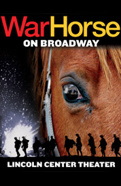War Horse Author Michael Morpurgo on How a Children's Novel Became an International Stage Sensation
About the author:
Sure, Harry Potter and the Twilight vampires became blockbuster movies, but the idea of bringing a children’s book about World War I cavalry horses to life in a theater sounds impossible. The creative minds at London’s National Theatre thought otherwise, and War Horse burst onto the stage to universal acclaim, thanks to the directing team of Marianne Elliott and Tom Morris, Handspring Puppet Company designers Adrian Kohler and Basil Jones, and adapter Nick Stafford. But it all started with a heartwarming novel by award-winning children’s author Michael Morpurgo, who envisioned a story of love and loyalty between a farm boy and his brave and beautiful horse. As Lincoln Center Theater’s production of War Horse prepares to open on April 14 at the Vivian Beaumont Theater, Broadway.com asked Morpurgo to describe what the experience of seeing his story transformed into a play—and now crossing the pond to Broadway—has meant to him.
![]()
The journey of War Horse from my little village of Iddesleigh in Devon (in the west of England, population less than a hundred) to the Vivian Beaumont Theater at Lincoln Center in New York, via the West End of London, via the National Theatre, has been a story in itself—an epic tale of great good fortune.
It all began with a chance conversation in the local pub, The Duke of York, nearly 30 years ago with an old soldier who had been to the First World War as a 17-year-old. “I was there with the ’orses,” he told me. After a beer or two he began to tell me more, about how the only “person” he could talk to of his fear, of his longing for home, was his horse. “I could tell that ’orse anything,” he said. “He was that good a friend to me. I came home after it was all over. He never did.”
I had read the first World War poems of Siegfried Sassoon and Wilfred Owen and Edward Thomas, I had seen Joan Littlewood’s iconic production of Oh What a Lovely War, I had read Erich Remarque’s All Quiet on the Western Front, but now I was talking to someone who had been there, seen it and suffered through it. I felt deeply honored that he was telling me, and moved beyond words. Yet I knew right away that somehow I had to find the words to pass his story on.
Soon after this fortuitous meeting, the discovery in our attic of a painting of cavalry horses charging into wire and becoming entangled prompted me to do more research. I found out from the Imperial War Museum in London that more than a million horses left our shores to go to that dreadful war, and only about 65,000 came back—and that was just on the British side. Thousands of those that survived were sold off to butchers in France after the war was over.
Now I knew I had to write this book, to tell the story of one of those horses, of the universal suffering of that war, of all wars. When it came out in 1982, War Horse nearly won the Whitbread Prize for best children’s book, but didn’t. It was well enough reviewed, published in the U.S., and translated into a few foreign languages, but then languished, rarely read, for 25 years. Luckily, luckily, and I have no idea why, it was kept in print by my kind and faithful publishers all this time.
In 2005, unbeknown to me, Tom Morris at the National Theatre was looking for a way to bring Handspring Puppets to his theater. These unique puppeteers from South Africa make life-size puppets that take center stage in their shows. Out of the blue, I heard that War Horse was being thought of as a future production, involving Handspring. So, how did Tom Morris ever come across my novel? Well, his mother read it, by chance, knew he was looking for a story with an animal at its heart and gave him a copy of War Horse.
During two years of workshops and preparation, the team came together: Marianne Elliott joining Tom Morris to direct, and Nick Hytner supporting the project all the way. The show was on. I think we all knew that with the design, the puppets, the music, the lighting, the actors and the story, we had the potential to create a unique theatrical experience. I witnessed some of their difficulties. It was a hard road, but everyone seemed utterly determined to make it work. And did they make it work! One of the world’s greatest actors passed me by at the end of that first night at the National Theatre and said, “That was the greatest anthem to peace I’ve ever seen.”
Two seasons later, seasons in which almost every ticket was sold, Joey trotted off to the West End. He may have new stables in the New London Theatre now, but the story being told and sung and acted is the same story—though it changes, grows, improves and sharpens all the time. Two more years on, after a thousand performances and an audience of over a million, Joey has come to New York. He and I have talked about it, and I’m telling you he loves being here. I mean, you know how much horses like apples, and the Bigger the Apple the better! So Joey’s a very happy horse, working alongside lots of new American friends. And if he’s happy, I’m happy.
War Horse, I have to tell you, is my wife Clare’s favorite story. And she has wonderful taste in stories—and in men. Well, that’s my story and I’m sticking to it.
